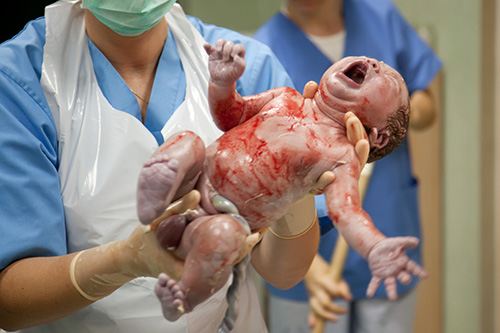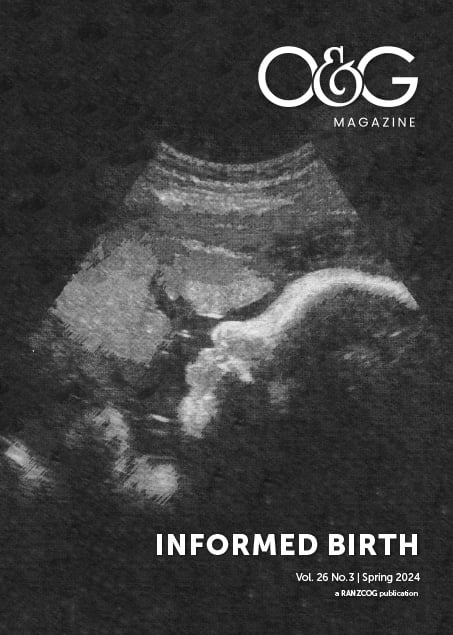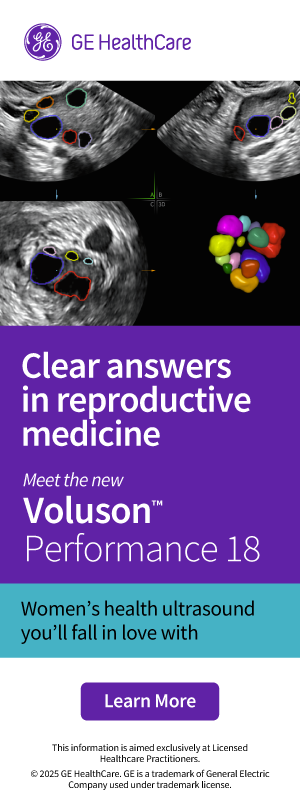If we are to look at informed birth, we need to also look at informed consent.
According to research,1 in Aotearoa, 50 women/birthing parents per day will report their birth as psychologically traumatic. Many more women will sustain some level of physical birth injury. Psychological trauma is characterised by intense anxiety, helplessness and loss of control.2
For some, their birth trauma – whether psychological or physical – will be unavoidable, but for many others their trauma is entirely avoidable and results from a lack of informed consent and a lack of agency during their birth.
Both the RANZCOG ‘Statement on Patient Consent and Duty to Inform’ and The Medical Council of New Zealand’s ‘Statement on Informed Consent’ note that informed consent is an interactive process between the doctor and patient, which gives those caring for the patient permission to proceed with treatment. It is the doctor’s responsibility to ensure informed consent is obtained and the patient has a right to refuse treatment.
Consent practices are inherently valuable because they promote autonomy; but they are also instrumentally valuable because they foster trust and can facilitate a safe and open therapeutic relationship.
The experience of informed consent during labour and birth
Those of us working in the maternity sector have a robust understanding of the definition of informed consent, but what about the experience of it? Aotearoa’s birth trauma community, sadly, holds many experiences where informed consent in the birth space was not obtained, the relevant information was not conveyed and where the birthing parent did not feel able to decline consent for treatment.
We often hear from the birth trauma community comments such as “I didn’t know this could happen” or “they never told me…” Information is a key component of informed consent. Whether in the birth space or within everyday life, we use information to make decisions that are best for us and our whānau. Information is power and we cannot make appropriate decisions, and we certainly aren’t empowered, if we don’t have all the information. Information needs to be shared at all stages of pregnancy, labour, birth and postpartum. Improved access to safe childbirth education is one piece of the information pie, but it is not a silver bullet.
Effective communication is a vital part of informed consent being an interactive process. This includes the language used and the ways in which situations, risks and treatments are explained to pregnant and birthing parents.
Georgia’s* experience of discussing a VBAC at an obstetrician appointment included the doctor saying, in front of Georgia’s husband and toddler: “Without constant monitoring, your baby will die” and: “You or your baby will die, you could leave your son without a mother.” The words spoken to Georgia and her family are coercive; coercion is not communication. Coercive remarks also often leave mothers feeling like they have no option but to accept the suggested treatment.
Grace speaks of how “they wanted me on the bed instead of the floor. That’s when the hands on started. Just because the mother changes position doesn’t grant you access to their body without asking”. Outside of the birth space, the need for consent before one person touches another is being quickly absorbed into our societal understanding. This needs to also happen inside the birth space.
Another part of effective communication is listening. Anna shares her story of not being believed almost leading to fatal consequences. “I was fobbed off by multiple nurses and midwives that my symptoms were all in my head and was about to be sent home when I spoke up one last time.
I was later told by the obstetrician that if we had gone home my baby and I would have both died. That comment still haunts me.”
The ethics of consent
Informed consent is important because it is morally transformative. Consent transforms an act that would be both illegal and unethical into an act that is socially condoned, ethically legitimate, and morally praiseworthy. To cut someone open without their consent is assault. But to, for example, surgically remove a tumour on a consenting patient is morally commendable. For consent to be valid and to have this transformative power it requires that the patient is competent to make medical decisions, is free from coercion and is fully informed about the procedure, risks, potential benefits and other options.
In the story above, the birthing woman is told that her baby “will” die. What makes this statement coercive? Coercion requires the use of physical force, or explicit or implicit threats of harm, to make someone do something against their will. Essentially it leaves the patient with no reasonable choice but to comply and, in this way, coercion undermines autonomy and informed consent.
Health providers assisting with birth may well be genuinely concerned about potential risks to either the mother or foetus and have an ethical duty to inform women. The statement that the baby “will die” is potentially coercive because it would be rare for the health provider to know this with certainty. It is reasonable for the birthing person to interpret this statement as a threat, rather than an effort to communicate. The key thing about coercion is that it wrests decision-making power away from the patient.
It is important to think about coercion within the social power dynamics at play in birth. Health providers have power over patients because patients are often sick, and this makes them vulnerable. Health providers are the gate keepers of a resource that patients need, and health providers have social and epistemic authority. Epistemic authority means we recognise health providers as having authority and power based on their professional knowledge and training. In this context, a coercive threat doesn’t need to be explicit. It can also include an implicit threat to withhold medical care or attention to which the patient is entitled.
Power differentials often seem much more obvious to the disempowered person and much smaller to the person in a position of power. Many women will say birth is one of the most difficult things they have experienced and is a time at which they were at their most vulnerable. Birth trauma is associated with being dismissed, ignored, belittled and bullied. This is a form of epistemic injustice3 which is an injustice related to knowledge, such as unfair distinctions in authority, unwarranted distrust, and in this case, the unfair downgrading of women as sources of relevant knowledge about their bodies and births.

Health providers may underestimate the power they have
in relation to patients and be unaware of the extent to which patients try to perform as a “good patient, good woman, good mother” to please their midwives, doctors and nurses. This can hamper a health provider’s ability to identify birth trauma either during or after birth. If a patient has lost trust that you are on her side and listening to her, she may go into survival mode, minimise interactions with you, communicate less honestly to avoid making herself more vulnerable, and may be aggressive or obstinate as a form of self-protection. All of this can pose challenges for health providers trying to navigate women towards a positive birth outcome.
Understating this behaviour in the context of social and epistemic power can help providers see that patients are sometimes using the only resources available to them to try to regain a sense of control in a situation that feels threatening, overwhelming and scary. Demonstrating patience, listening and humility can help diffuse tensions and nurture trust. Assertiveness, pressure or implicit threats may seem appealing to providers if they lead to a prompt and safe delivery, but they can cause long-term trauma and harm to the mother and, consequently, their baby. Delivery of a healthy baby is no indication that the birthing personis OK. And we know from public inquires, empirical research and lived experience that providers are often unaware that their patients have experienced trauma.
Where to from here?
When genuine informed consent occurs in the pregnancy/birthing context, its positive impacts can ripple out into the entire whānau. Maia’s experience of informed consent involved having information shared regarding “all my questions, about possible outcomes and options, including if I chose to do nothing.” This experience left Maia feeling confident and supported.
If we are to see any change in birth trauma prevalence, we need more conversations about informed consent and women’s agency during birth. Consumers need to have these conversations with practitioners; but they are also needed among the professions and stakeholder groups within the maternity sector.
These conversations should be open, honest, upfront and solutions focused. They need to include all stakeholders, particularly the birth trauma community and the many insights that can be gleaned from this community’s combined experiences.
These stakeholder conversations can result in agreement on the changes needed to improve informed consent practices; for example, improved training opportunities and increased resourcing across the maternity sector.
Interactions between birthing parents and those caring for them directly impacts the birth experience. Birth experience, in turn, directly impacts the birthing parent and their whānau into the future. We have an opportunity to greatly improve whānau experiences of birth, and therefore whānau life after birth, if we kōrero about, and then improve, informed consent practice.
*Names have been changed to protect privacy.
About the authors:
Kate Hicks, BRM, MTM is Founder and Chief Executive of Birth Trauma Aotearoa – a registered charitable trust undertaking education, advocacy, research and support services regarding both physical and psychological birth trauma. Kate is also creator of the Aotearoa-focused My Birth Story birth trauma support website. Kate lives in rural Manawatū.
Associate Professor Angela Ballantyne, PhD Bioethics, from Department Primary Health Care and General Practice teaches medical ethics at the University of Otago (Wellington) School of Medicine. Angela’s research interests include exploitation, research ethics, vulnerability, ethics of pregnancy and reproductive technologies, unconscious bias, global health and justice, and feminist bioethics. Angela is also a Founding Board Member of Birth Trauma Aotearoa.
References
- Soet JE, Brack GA, Dilorio C. Prevalence and predictors of women’s experiences of psychological trauma during childbirth. Birth. 2003 Mar;30(1): 36–46
- Peichl, L. (2007). Child Abuse Research in South Africa – Reventing a cycle of disruptive behaviour in girls: group counselling across cultures. South African Society on the Abuse of Children, 13(2): 13-21.
- Fricker, M. (2007). Epistemic Injustice: Power and the Ethics of Knowing (Oxford, 2007; online edn, Oxford Academic, 1 Sept. 2007), doi.org/10.1093/acprof:oso/9780198237907.001.0001, accessed 30 June 2024.







Leave a Reply